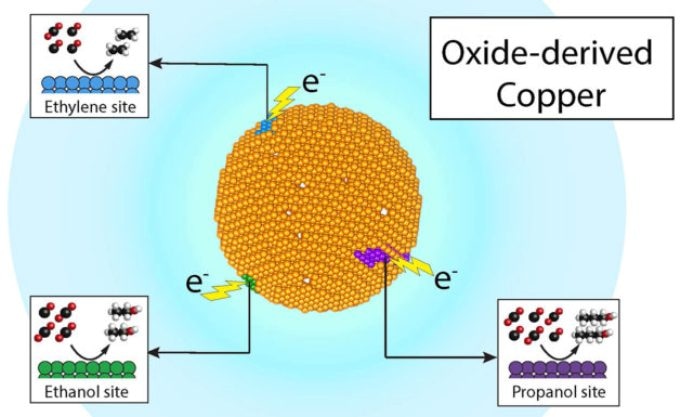Dec 18 2018
For many years, researchers have been looking for effective methods to remove excess emissions of carbon dioxide from the air and recycle them into products like renewable fuels.
 Researchers at Berkeley Lab and the Joint Center for Artificial Photosynthesis have demonstrated that recycling carbon dioxide into valuable chemicals such as ethylene and propanol, and fuels such as ethanol, can be economical and efficient—all through product-specific “active sites” on a single copper catalyst. (Image credit: Ager and Lum/Berkeley Lab)
Researchers at Berkeley Lab and the Joint Center for Artificial Photosynthesis have demonstrated that recycling carbon dioxide into valuable chemicals such as ethylene and propanol, and fuels such as ethanol, can be economical and efficient—all through product-specific “active sites” on a single copper catalyst. (Image credit: Ager and Lum/Berkeley Lab)
However, it is a costly, tedious, and wasteful process to convert carbon dioxide gas into valuable chemicals; hence, it is not environmentally or economically viable.
Now, scientists at the U.S. Department of Energy’s Lawrence Berkeley National Laboratory (Berkeley Lab) and Joint Center for Artificial Photosynthesis (JCAP) have demonstrated that a single copper catalyst can be used to recycle carbon dioxide into useful fuels and chemicals in an efficient and economical manner. The study has been published in the journal Nature Catalysis on December 17th, 2018.
Going where the action is: product-specific active sites
A piece of copper metal may feel smooth to touch; however, the same surface is, in fact, bumpy at the microscopic level. Researchers have termed these bumps as “active sites,” stated Joel Ager, a JCAP researcher who headed the research. Ager is also a staff scientist in Berkeley Lab’s Materials Sciences Division and an adjunct professor in the Department of Materials Science and Engineering at UC Berkeley.
It is at these active sites where the magic of electrocatalysis occurs: electrons from the surface of copper interact with water and carbon dioxide in a sequential manner, converting them into products such as ethanol fuel; propanol, which is an alcohol often utilized in the pharmaceutical sector; and ethylene, which is the precursor to plastic bags.
The ability of copper to convert carbon into many different valuable products was discovered in the 1980s, and since then, it was invariably believed that its active sites were not product-specific—to put this in simple terms, copper could be used as a catalyst for making ethylene, ethanol, propanol, or some other chemical based on carbon; however, a lot of steps have to be performed to isolate the unnecessary and remaining chemicals that are formed at the time of the intermediate stages of a chemical reaction prior to arriving at the final destination—that is, the chemical end-product.
The goal of ‘green’ or sustainable chemistry is getting the product that you want during chemical synthesis. You don’t want to separate things you don’t want from the desirable products, because that’s expensive and environmentally undesirable. And that expense and waste reduces the economic viability of carbon-based solar fuels.
Joel Ager, Researcher, Joint Center for Artificial Photosynthesis, Lawrence Berkeley National Laboratory.
Hence, when Ager and co-author Yanwei Lum, a UC Berkeley PhD student in Ager’s lab during the study, were inspecting the catalytic properties of copper for a solar fuel project, they speculated, “What if, like photosynthesis in nature, we could use electrons from solar cells to drive specific active sites of a copper catalyst to make a pure product stream of a carbon-based fuel or chemical?”
Tracing a chemical’s origins through its “passport”
Studies performed in the past had demonstrated that ethylene, ethanol, and propanol can be made with rusted or “oxidized” copper, which is an excellent catalyst. The investigators hypothesized that if active sites in copper were truly product-specific, then it would be possible to trace the origins of chemicals via carbon isotopes, “much like a passport with stamps telling us what countries they visited,” said Ager.
When we thought of the experiment, we thought that this is such an unobvious idea, that it would be crazy to try it. But we couldn’t let it go, because we also thought it would work, as our previous research with isotopes had enabled us to discover new reaction pathways.
Joel Ager, Researcher, Joint Center for Artificial Photosynthesis, Lawrence Berkeley National Laboratory.
Therefore, Ager and Lum ran a set of experiments for the next few months using two carbon isotopes—carbon-12 and carbon-13—as “passport stamps.” Carbon dioxide and carbon monoxide—a main intermediate in the formation of carbon-carbon bonds—were labeled with carbon-12 and carbon-13, respectively. In accordance with their methodology, the scientists reasoned that the ratio of carbon-13 vs. carbon-12—the “isotopic signature”—present in a product would help in determining the origin of the chemical product from specific active sites.
Once Lum performed many experiments and applied advanced nuclear magnetic resonance (NMR) spectroscopy and mass spectrometry at JCAP to examine the results, the team found that three of the products—such as ethanol, ethylene, and propanol—possessed varied isotopic signatures demonstrating that they originated from different sites on the catalyst.
This discovery motivates future work to isolate and identify these different sites. Putting these product-specific sites into a single catalyst could one day result in a very efficient and selective generation of chemical products.
Yanwei Lum, Study Co-Author, PhD Student, UC Berkeley.
Green days ahead for chemical manufacturing
The new methodology of the researchers—what Ager calls as “straightforward chemistry with an environmental and economic twist”—is what they believe can be a novel beginning for the manufacture of green chemicals where a solar cell can possibly feed electrons to particular active sites inside a copper catalyst to improve the production of ethanol fuels.
“Perhaps one day this technology could make it possible to have something like an oil refinery, but powered by the sun, taking carbon dioxide out of the atmosphere and creating a stream of useful products,” he stated.
The Joint Center for Artificial Photosynthesis is a DOE Energy Innovation Hub. The DOE Office of Science supported the study.